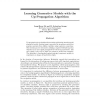Free Online Productivity Tools
i2Speak
i2Symbol
i2OCR
iTex2Img
iWeb2Print
iWeb2Shot
i2Type
iPdf2Split
iPdf2Merge
i2Bopomofo
i2Arabic
i2Style
i2Image
i2PDF
iLatex2Rtf
Sci2ools
106
Voted
NIPS
1997
1997
Learning Generative Models with the Up-Propagation Algorithm
Up-propagation is an algorithm for inverting and learning neural network generative models. Sensory input is processed by inverting a model that generates patterns from hidden variables using top-down connections. The inversion process is iterative, utilizing a negative feedback loop that depends on an error signal propagated by bottom-up connections. The error signal is also used to learn the generative model from examples. The algorithm is benchmarked against principal component analysis in experiments on images of handwritten digits. In his doctrine of unconscious inference, Helmholtz argued that perceptions are formed by the interaction of bottom-up sensory data with top-down expectations. According to one interpretation of this doctrine, perception is a procedure of sequential hypothesis testing. We propose a new algorithm, called up-propagation, that realizes this interpretation in layered neural networks. It uses top-down connections to generate hypotheses, and bottom-up connec...
Related Content
| Added | 01 Nov 2010 |
| Updated | 01 Nov 2010 |
| Type | Conference |
| Year | 1997 |
| Where | NIPS |
| Authors | Jong-Hoon Oh, H. Sebastian Seung |
Comments (0)

